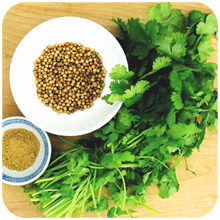
Coriander (Coriandrum sativum) is an annual herbaceous plant species of umbelifere family, exclusively cultivated, 30-100 cm tall, with white or pink flowers and globe-shaped fruit. Swivel root is thin, poorly branched. The stem is cylindrical glabrate with fine furrows, ramified on only at the top. The leaves are pale green, glabrous, very differentiated by the level at which they are found: the basal ones are rosette- with long petiolate, entire, crenate or have trilobite edge to trifoliate, the medium once are alternate, once or twice pinnate, sectioned, wide, unequally pinnate lobed; upper leaves are sessile, three times pinnate rarely laciniate, narrow, filiform. The flowers are grouped into composite umbel with long peduncle, 3-7 radii and without involucre; they are the type of 5 petals white or slightly pink-purple in color, uneven at the edge of the inflorescence, the external petal is much higher (up to 4 mm). Diachene fruits are spherical, with a diameter of 2-6 mm, yellow-brown or brownish in color, with the two halves joined together, each mericarp has 5 striated ribs and 4 more pronounced maintaining the rest of calyx on the apex and the two stigmas, which have a pleasanr aroma at from maturity.
Chemical composition – Fruit contains volatile oil consisting of linalool or coriandrol, geraniol, Cymol, pinene, terpinene, phelaandren, dipentene, petroselinic acid etc.. Also contains lipids, starch, minerals, pectin etc.
Properties – Carminative, stomachic, stimulant aromatic, bactericide, fungicide, stimulates gastrointestinal secretions, anthelmintic, calming action on gastrointestinal tract, mild antibacterial and antispasmodic.
Recommenation – Flatulence, anorexia, nervous weakness, bloating, bronchitis, intestinal colic, biliary dyskinesia, digestive dyspepsia, abdominal pain, gastritis, hyperacidity, helminthiasis, poor lactation, rheumatism, sinusitis, stomach ulcer, swelling, intestinal worms.
This plant is incorporated in natural remedy WORM END Syrup.




